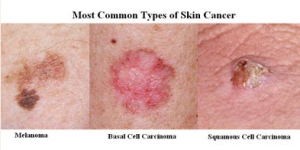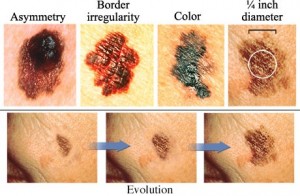What is skin cancer?
Skin cancer is the uncontrolled growth of abnormal skin cells. It occurs when unrepaired DNA damage to skin cells triggers mutations, or genetic defects, that lead the skin cells to multiply rapidly and form malignant tumors.
There are three major types of skin cancer basal cell carcinoma, squamous cell carcinoma and melanoma.
Warning Signs: The ABCDEs
Asymmetry. One half doesn’t match the appearance of the other half.
Border irregularity. The edges are ragged, notched, or blurred.
Color. The color is not uniform. Shades of tan, brown, and black are present. Dashes of red, white, and blue add to a mottled appearance.
Diameter. The size of the mole is greater than 1/4 inch. Any growth of a mole should be evaluated.
Evolution. There is a change in the size, color, shape and symptoms – such as itching or tenderness or bleeding
As a general rule, to spot skin cancers, take note of any new moles or growths, and any existing growths that begin to grow or change significantly in any other way.
Risk Factors
- Fair skin.
- A history of sunburns
- Excessive sun exposure.
- A family or personal history of skin cancer.
- A personal history of skin cancer.
- A weakened immune system.
- Exposure to radiation.
Prevention
- Avoid the sun during the middle of the day. The sun’s rays are strongest between about 10 a.m. and 4 p.m. Schedule outdoor activities for other times of the day, even in winter or when the sky is cloudy.
- Wear sunscreen year-round. Use a broad-spectrum sunscreen with an SPF of at least 30. Apply sunscreen generously every two hours or more often if you’re swimming or perspiring.
- Wear protective clothing and sunglasses.
- Avoid tanning beds.
- Be aware of sun-sensitizing medications. Some common prescription and over-the-counter drugs, including antibiotics, can make your skin more sensitive to sunlight.
- Check your skin regularly and report changes to your doctor. Examine your skin often for new skin growths or changes in existing moles, freckles, bumps and birthmarks.
For more information on protecting you and your family from the sun visit the American Cancer Society at www.cancer.org


